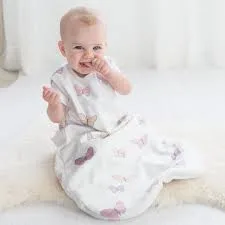-
×
 Boys and girls solid color vest, large size 8/14 years old 1 × $978.00
Boys and girls solid color vest, large size 8/14 years old 1 × $978.00 -
×
 H546 Newborn set-SS01_ 9/36m printed 1 × $456.00
H546 Newborn set-SS01_ 9/36m printed 1 × $456.00 -
×
 H549 Children's swimwear - SW01_2/12 BT 1 × $648.00
H549 Children's swimwear - SW01_2/12 BT 1 × $648.00
News
Guide to choosing materials for sensitive baby skin
Part 1: The Essential Fabric Guide – Natural Fibers for Sensitive Baby Skin
Introduction: The Skin-Clothing Connection
A baby’s skin is their largest and most delicate organ—five times thinner and far more permeable than adult skin. This heightened sensitivity means that the fabric a child wears is not just about comfort; it is a critical factor in their health and well-being. Choosing the wrong material can lead to irritation, eczema flare-ups, and allergic reactions, while choosing the right one provides a crucial layer of protection.
This comprehensive guide serves as the ultimate Fabric Selection Manual for Sensitive Baby Skin. We will move beyond marketing buzzwords to provide a detailed, balanced comparison of the most popular natural textiles: Organic Cotton, Bamboo Fiber, Linen, and Wool (Merino). By understanding the unique strengths and weaknesses of each, parents can curate a wardrobe that prioritizes health, breathability, and natural comfort.
I. Organic Cotton: The Dermatologist’s Favorite
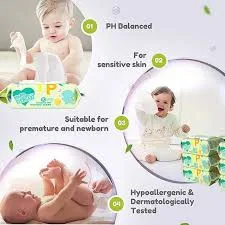
Organic Cotton is cultivated without synthetic pesticides, toxic fertilizers, or GMOs. Its status as the gold standard in baby wear is well-earned, primarily due to its purity and familiar feel.
A. Advantages (Pros)
- Chemical Purity (Skin Health Focus): The primary benefit is the absence of residual toxins from farming and processing (when GOTS certified). This makes it inherently hypoallergenic and the top choice for babies with eczema or severe contact dermatitis.
- Unrivaled Breathability: Cotton’s natural fiber structure allows for exceptional air circulation, preventing heat buildup and minimizing the risk of heat rash or skin infections in warm climates or humid conditions.
- Softness and Durability: Organic fibers are often stronger and softer than conventional cotton because they haven’t been damaged by harsh chemicals. They get softer with every wash, making them ideal for daily essentials and hand-me-downs.
- Accessibility: As a widely cultivated crop, organic cotton garments are increasingly accessible across various price points and brands.
B. Disadvantages (Cons)
- Water Absorption vs. Wicking: While cotton is highly absorbent (good for sopping up drool/spills), it retains moisture rather than wicking it away quickly. If a baby sweats heavily or the diaper leaks, the damp fabric stays against the skin, potentially leading to discomfort or irritation.
- Wrinkle Proneness: Cotton wrinkles easily, often requiring ironing or steaming to maintain a crisp appearance, which can be an inconvenience for busy parents.
- Drying Time: It typically takes longer to air dry compared to synthetics or bamboo, posing a challenge in high-rotation situations.
II. Bamboo Fiber (Viscose/Lyocell): The Thermo-Regulating Miracle
Bamboo fabric has surged in popularity, prized for its silk-like touch and unique performance features, particularly for infants and sleepwear.
A. Advantages (Pros)
- Exceptional Softness (Comfort Focus): Bamboo has a luxuriously soft, silky texture that is remarkably gentle on the most sensitive skin, offering minimal friction compared to other fibers.
- Superior Thermo-Regulation: The fiber contains micro-gaps that allow for excellent ventilation. It has a natural cooling effect in summer and offers light insulation in winter, making it ideal for maintaining an infant’s core temperature.
- Moisture Wicking: Unlike cotton, bamboo actively wicks moisture (sweat) away from the skin, preventing dampness and associated rashes, making it excellent for hot sleepers or active toddlers.
- Natural Antibacterial Properties: Bamboo contains “Bamboo Kun,” a bio-agent that helps inhibit the growth of bacteria, making the garments naturally odor-resistant and contributing to better skin hygiene.
B. Disadvantages (Cons)
- Processing Concern (Sustainability Focus): While the plant itself is highly sustainable, traditional production of Bamboo Viscose (Rayon) involves chemical solvents that can be harmful to the environment if not managed in a closed-loop system. Parents should prioritize Bamboo Lyocell (which uses a gentler, recycled solvent) for the best ecological choice.
- Durability: While soft, pure bamboo fabric can sometimes be less robust than cotton and may be prone to pilling or showing wear faster, especially in high-stress areas.
- Drape: The beautiful drape can sometimes translate to a less structured garment compared to cotton, making it less suitable for items requiring a stiff form (e.g., jackets or structured trousers).
III. Linen: The Ancient, Cool Warrior
Linen, derived from the flax plant, is one of the oldest textiles in the world. It is celebrated for its natural texture and incredible cooling properties.
A. Advantages (Pros)
- Extreme Breathability and Cooling: Linen is highly porous, making it the most breathable natural fabric. It can absorb a massive amount of moisture before feeling damp, and its structure allows heat to escape quickly, making it the superior choice for extremely hot and humid climates.
- Strength and Durability: Linen fibers are incredibly strong. It is one of the longest-lasting natural fabrics and, like organic cotton, actually improves with age and washing, becoming softer over time.
- Naturally Hypoallergenic: Flax cultivation is generally low-input, making linen an excellent hypoallergenic choice free from the chemical residue concerns of conventional cotton.
B. Disadvantages (Cons)
- Initial Texture: High-quality linen can feel stiff or coarse when brand new, requiring several washes to achieve desirable softness. For a newborn or extremely sensitive skin, this initial texture might cause irritation.
- Wrinkles Heavily: Linen wrinkles almost instantly and significantly. While this is often viewed as part of its charm (the “perfectly imperfect” look), it can appear messy and may not suit all occasions.
- Cost: Processing flax is labor-intensive, making linen garments generally more expensive than cotton or bamboo alternatives.
Part 2: Merino Wool, Comparative Analysis, and Practical Application
IV. Merino Wool: The Temperature-Regulating Wonder
When the word “wool” comes up, many parents immediately think of scratchy sweaters. However, Merino Wool is a class apart, possessing unique properties that make it highly beneficial for sensitive skin, especially in specific climates.
A. Advantages (Pros)
- Exceptional Thermo-Regulation: Merino wool fibers are incredibly fine and crimped, creating millions of air pockets. This allows them to effectively trap heat in cold weather while simultaneously releasing excess heat and moisture in warm conditions. It is ideal for layering and regulating the fluctuating body temperature of infants.
- Superior Moisture Management: Unlike cotton (which gets damp), Merino wool is hydrophilic (attracts water) and can absorb up to 35% of its own weight in moisture before feeling wet. Crucially, it retains its insulating properties even when damp, preventing a chill—a key safety feature.
- Ultra-Fine and Non-Irritating: High-quality Merino wool fibers are much finer than traditional wool, making them soft and flexible. Research has shown that wearing superfine Merino wool can actually reduce the severity of eczema in children by buffering the skin’s microclimate.
- Naturally Anti-Odor and UV Resistant: It naturally resists the build-up of bacteria, meaning garments stay fresh longer and require less frequent washing. It also offers a natural level of UV protection.
B. Disadvantages (Cons)
- Cost: Merino wool is often the most expensive option due to the specialized sourcing and processing required. This can be a barrier for high-volume items.
- Care Requirements: It often requires gentle hand-washing or specific wool cycles and careful drying to prevent shrinkage or felting, making it higher maintenance than cotton.
- Perceived Irritation: While scientifically proven to be non-irritating, some children (or parents) may have a psychological association with “wool” being scratchy, requiring an initial trial period.
V. Comparative Fabric Selection Guide for Sensitive Skin
The “best” fabric depends entirely on the climate, the child’s specific skin condition, and the purpose of the garment. Here is a comparative analysis of the four natural fibers:
A. Strategic Fabric Blending
Often, the most functional garment for a sensitive baby is a blend of these natural fibers:
- Cotton-Bamboo Blend: Combines the trusted stability of cotton with the silky soft feel and wicking properties of bamboo—ideal for all-season pajamas and daywear.
- Merino-Silk Blend: Adds the strength and extra softness of silk to Merino wool, making it less fragile and perfect for thermal underlayers.
VI. Practical Mẹo for Parents: Making the Final Choice

Choosing the right material is only the first step. Proper garment management is equally crucial for protecting sensitive skin.
A. Decoding Labels and Certifications (Actionable Tips)
- GOTS Certification (The Gold Standard): Always prioritize GOTS (Global Organic Textile Standard) certification, especially for cotton and bamboo. This verifies not only organic farming but also the non-toxic and non-allergenic dyeing and finishing processes. This is the single most important defense against chemical skin irritants.
- OEKO-TEX Standard 100 (Safety First): Look for this label on all fabric types. It guarantees the final product, including threads, zippers, and snaps, has been tested and is free from harmful levels of substances. For babies, look for Class I certification.
- Avoid “Viscose” Unless Qualified: If a label says “Bamboo Viscose” or “Bamboo Rayon,” check the brand’s website to see if they use a closed-loop system. If in doubt, opt for the safer, more eco-friendly Organic Cotton or Bamboo Lyocell.
B. Laundry Protocol for Sensitive Skin
The cleaning process is often the biggest source of skin irritation, even with the best natural fibers.
- Use Hypoallergenic Detergent: Choose detergents that are dye-free, fragrance-free, and specifically labeled “free and clear”. Harsh chemicals and perfumes left behind in the fibers can negate the benefits of natural fabric.
- Double Rinse Cycle: Always run an extra rinse cycle to ensure all detergent residue is completely removed from the fabric, preventing contact irritation.
- Avoid Fabric Softeners and Bleach: These products contain chemicals and perfumes that coat the fibers, reducing their breathability and potentially triggering skin reactions. Natural fabrics like cotton and linen become softer naturally over time.
- Remove Tags and Labels: Immediately cut off all internal tags and labels, as their stiff edges are a common cause of scratching and irritation on delicate skin.
Part 3: Sustainability Economics, Future Trends, and Final Verdict
VII. The Economics of Sustainable Fabrics for Children
While the initial cost of certified natural fibers might be higher than conventional fabrics, the long-term economic and environmental value proposition strongly favors sustainable choices.
A. Cost-Per-Wear vs. Initial Price
- Durability and Longevity: High-quality natural fibers like Organic Cotton, Linen, and Merino Wool are inherently stronger than fast-fashion synthetics or chemically-weakened conventional cotton. They resist pilling, maintain shape better, and withstand repeated washing cycles. This extended life means a lower cost-per-wear over time.
- Hand-Me-Down Value: Because these garments retain their integrity and color, they are perfectly suited for hand-me-downs between siblings or friends. This multi-child use dramatically lowers the total investment per family.
- Resale Value: Due to their ethical sourcing and proven durability, clothing made from certified organic and natural fibers maintains a significantly higher resale value on second-hand platforms, helping parents recoup their initial investment.
B. The True Cost of Conventional Fabric
Choosing cheap, conventional clothing carries hidden costs that impact both the child and the planet:
- Health Costs: Increased frequency of eczema or allergic reactions may lead to higher costs for specialized creams, medications, and doctor visits.
- Replacement Costs: Poor quality leads to faster degradation (holes, fading, stretching), requiring more frequent replacement purchases.
- Environmental Cost: Supporting conventional farming contributes to water scarcity and pesticide use, creating a massive long-term ecological debt that future generations must pay.
VIII. Emerging Trends and The Future of Baby Fabric
The market for sensitive baby skin is constantly innovating, driven by demand for even higher performance and sustainability.
A. The Rise of Regenerative Fibers
Beyond the established quartet, two emerging trends are gaining traction:
- Hemp: Highly sustainable to grow (requires minimal water, no pesticides, enriches the soil). Hemp fabric is incredibly strong, durable, and naturally antimicrobial. While traditionally coarser, modern processing techniques are producing softer blends perfect for children’s wear.
- Recycled Fibers (R-PET Blends): While not natural, recycled polyester (from plastic bottles) is being increasingly used in blends with natural fibers for performance outerwear. When blended responsibly, it provides durability and wicking properties while diverting waste from landfills. For sensitive skin, these blends should only be used in outer layers and backed by OEKO-TEX certification.
B. Smart Fabrics and Seamless Construction
The future is leaning towards clothes that act as a “second skin”:
- Seamless Knitting: Techniques that eliminate bulky side seams and tags are vital for children with severe eczema, minimizing friction points that cause flare-ups.
- Probiotics and Finishes: Research is exploring natural finishes, such as incorporating beneficial probiotics or natural skin-soothing agents (like aloe vera) directly into the fabric, to actively help manage skin conditions.
IX. Final Verdict: The Fabric Checklist for Conscious Parenting
The core mission of dressing a child with sensitive skin is to create a protective, breathable, and pure barrier against the world. No single fiber is universally perfect, but armed with knowledge, parents can make informed choices.
The ultimate fabric checklist should always prioritize these three non-negotiables:
- Purity First: Always choose GOTS Certified Organic Cotton or Bamboo Lyocell to eliminate contact with residual pesticides and toxic dyes.
- Climate Match: Match the fabric to the child’s environment: Linen or Bamboo for heat/humidity; Merino Wool or durable Cotton for varying temperatures and layering.
- Performance Needs: Select for Wicking (Bamboo/Merino) for heavy sweaters/active play, and High Absorption (Cotton/Linen) for everyday wear and mess management.
By embracing this comprehensive guide, parents move beyond simple color and design to make fabric choices that support their child’s health, confidence, and the sustained health of the planet.
The choice is clear: choose nature, choose health, choose the future.
Part 4: Processing Methods, Case Studies, and Future Fabric Innovations (
X. The Critical Role of Fabric Processing Methods
Even the purest natural fiber can become an irritant if subjected to harsh post-production processing. Conscious consumers must pay attention not just to how the fiber is grown, but how it is turned into cloth.
A. Dyes: The Hidden Irritant
Many brightly colored baby clothes use Azo dyes or other synthetic colorants containing heavy metals, which are notorious skin irritants and hormone disruptors.
- Non-Toxic Dyes: Prioritize clothes colored with low-impact, non-toxic dyes (often vegetable or mineral-based). GOTS certification is crucial here, as it strictly limits the use of toxic inputs throughout the dyeing process.
- Natural Colors: Some brands utilize naturally colored Organic Cotton (e.g., shades of green, brown, tan grown naturally on the plant), eliminating the need for any dyeing process altogether—the safest option for extremely sensitive skin.
B. Finishing Chemicals: The Breathability Killer
To make fabrics wrinkle-free, water-resistant, or flame-retardant, manufacturers often use chemical finishes like formaldehyde, PFAS, or brominated flame retardants.
- Formaldehyde-Free: Always ensure clothing is labeled Formaldehyde-free. Formaldehyde is a known irritant and allergen frequently used to enhance wrinkle resistance in cotton.
- Natural Flame Retardants: Opt for fabrics that are naturally less flammable (like Merino Wool or dense weaves of Organic Cotton) or those treated with mineral-based, non-toxic flame retardants, especially for sleepwear.
XI. Case Study Analysis: Matching Fabric to Specific Skin Conditions
Understanding how specific fibers interact with common skin conditions allows for highly personalized and effective clothing choices.
A. Case Study 1: Managing Severe Eczema
- Primary Need: Minimize friction and regulate temperature to prevent itching/scratching cycles.
- Best Fabric Strategy: Merino Wool (superfine) for base layers or sleepwear. Studies show Merino’s unique ability to buffer the skin’s microclimate (keeping it stable) can significantly reduce eczema severity. Alternatively, Organic Cotton base layers that are non-dyed and GOTS certified for purity.
- Worst Fabric: Conventional cotton (due to chemical residue) or anything with stiff seams/labels (due to friction).
B. Case Study 2: Preventing Heat Rash in Summer
- Primary Need: Maximum breathability and rapid moisture wicking.
- Best Fabric Strategy: Linen or Bamboo Lyocell. Linen provides the fastest heat release, while Bamboo actively wicks sweat away from the skin, preventing moisture from lingering in skin folds.
- Worst Fabric: Thick, heavy conventional cotton or synthetic polyester that traps heat and moisture.
XII. Looking Ahead: Driving Innovation for Skin Health
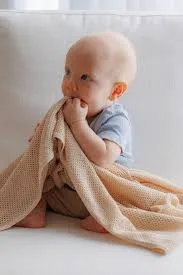
The future of baby textiles lies in bio-innovation that merges performance with natural purity.
A. Bio-Based Alternatives and Circular Economy
The focus will shift to textiles that are not only natural but also biodegradable:
- Tencel (Lyocell): Already widely used, Lyocell made from wood pulp (often Eucalyptus) is highly sustainable, incredibly soft, and boasts excellent wicking properties. It is often cited as a more consistent alternative to Bamboo Lyocell.
- Mushroom and Algae-Based Dyes: Replacing synthetic colorants entirely with bio-based, non-toxic, and renewable sources derived from organisms like fungi and algae.
B. Consumer Advocacy and Industry Responsibility
The responsibility for cleaner, healthier fabrics rests on both the consumer and the manufacturer:
- Consumer Power: Every purchase of certified, pure fabric is a vote against harmful practices. Consumers must continue to demand transparency regarding dyeing and finishing processes.
- Manufacturer Commitment: Brands must commit to universal use of the closed-loop Lyocell system for all regenerated cellulose (Bamboo/Tencel) and achieve GOTS certification across 100% of their cotton supply chain.
Conclusion: The Ultimate Verdict on Fabric for Sensitive Skin
The choice of clothing for a baby with sensitive skin transcends fashion; it is a profound decision rooted in health, ethics, and environmental stewardship. After a deep dive into the comparative advantages of Organic Cotton, Bamboo Fiber, Linen, and Merino Wool, the verdict is clear: Purity and performance must never be compromised.
The Three Pillars of Protection
We established that the ideal fabric must fulfill three critical roles to protect a child’s delicate skin:
- Purity and Hypoallergenicity: The fabric must be free from residual pesticides, toxic dyes, and harmful finishing chemicals. Organic Cotton (GOTS-certified) stands as the most trusted barrier against these irritants, making it the non-negotiable foundation for every sensitive skin wardrobe.
- Performance and Comfort: The material must actively manage the skin’s microclimate. Bamboo (Lyocell) and Merino Wool excel here, offering superior thermo-regulation and moisture-wicking properties that prevent dampness and minimize friction—the key triggers for eczema and rashes.
- Sustainability and Ethics: Choosing natural fibers like Hemp and Linen, and supporting closed-loop processing for bamboo, aligns the child’s well-being with the health of the planet they will inherit. This commitment ensures that the health of the farmer and the cleanliness of the water are valued as highly as the softness of the final garment.
From Choice to Confidence
Ultimately, this comprehensive guide empowers parents to move past generic marketing. By focusing on verifiable certifications like GOTS and OEKO-TEX Class I, and by understanding the unique performance profile of each natural fiber, parents gain the confidence to make highly personalized, proactive choices.
The simple act of prioritizing a pure, breathable, and durable wardrobe is the most effective, non-invasive treatment for a child with sensitive skin. It is an investment in their comfort, health, and a cleaner, greener future.
Choose nature, choose health, choose the future.
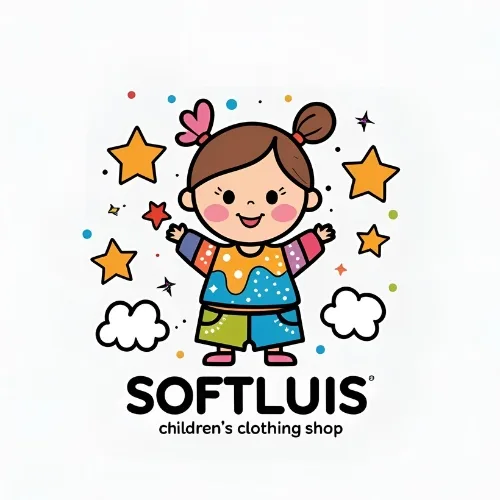
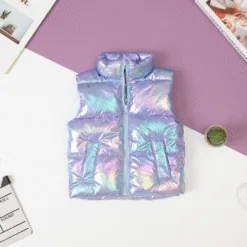 Boys and girls solid color vest, large size 8/14 years old
Boys and girls solid color vest, large size 8/14 years old 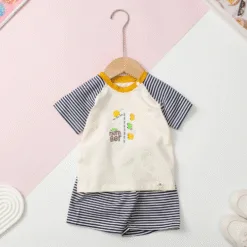 H546 Newborn set-SS01_ 9/36m printed
H546 Newborn set-SS01_ 9/36m printed 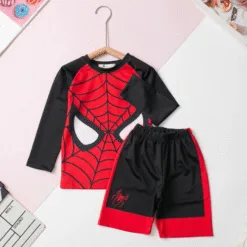 H549 Children's swimwear - SW01_2/12 BT
H549 Children's swimwear - SW01_2/12 BT 